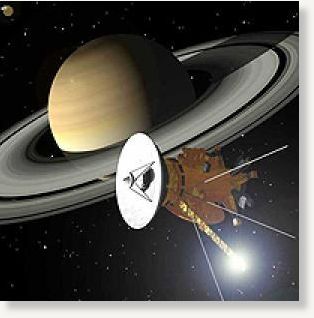
© NASACassini spacecraft approaching Saturn
Scientists studying Saturn have detected a glowing patch of ultraviolet light
that marks the presence of an electrical circuit connecting the planet with its moon Enceladus, they report today in the journal
Nature.
Long theorized, but not previously seen, the newly discovered bright patch indicates that electrically charged particles travel between Saturn and Enceladus, interacting with the planet's magnetic field lines. This makes a glowing patch near the planet's north pole, caused by a similar phenomenon to the northern and southern lights ( or aurora ) on Earth.
The new observation comes from Cassini, a NASA spacecraft that has been in orbit around Saturn since 2004, and is managed by the Jet Propulsion Laboratory in California. Scientists at Imperial College London made the discovery along with Cassini colleagues from the United States and Europe.
"This is an important revelation about the link between the tiny moon Enceladus and its parent planet Saturn. It also yields more information about the giant gas-planet's surprising magnetic field, which is yet to be fully understood even after Cassini's 7 years in orbit," said Professor Michele Dougherty from the Department of Physics at Imperial College London, who leads Cassini's magnetometer team.
Scientists have discovered that electrically charged particles travel between Saturn and Enceladus"The magnetic field that has thus far been measured from Saturn's interior is very different from that observed at other planets. Unlike these, Saturn has almost no difference between the axis of rotation and the axis about which the magnetic field is centred. We simply do not yet understand why this is the case," she said.
For years, scientists have tried using other space telescopes to search Saturn's poles for evidence of glowing patches, but without success. Studies of the planet Jupiter have shown that its volcanically active moon Io creates glowing footprints near the planet's north and south poles, so they suspected there would be an analogous electrical connection between Saturn and Enceladus.
Now, Cassini's unique view from its planetary orbit has given its scientific instruments the opportunity to detect new faint features. At its brightest, the footprint shines with an ultraviolet light intensity far less than Saturn's polar aurora, but comparable to the faintest Earth aurora visible without a telescope. The newly discovered auroral footprint measures about 1,200 kilometres ( 750 miles ) by less than 400 kilometres ( 250 miles ), covering an area comparable to that of Sweden.
Enceladus is the only known active moon in the Saturn system, with geysers spraying water vapour and organic particles into space. This creates a massive, electrically charged 'plasma' cloud which shoots energetic electrons along magnetic field lines toward the north pole of Saturn, producing the aurora-like glowing patch on the planet. The new data from Cassini illustrate how these effects on Enceladus, a massive 240,000 kilometres ( 150,000 miles ) away from Saturn, affect the planet's magnetic field.
According to the scientists, the footprint appears to flicker, leading them to believe the rate at which Enceladus is spewing particles may vary. "The new data are adding fuel to the fire of some long-standing debates about this active little moon," said Abigail Rymer, a lead author of the study and a Cassini team scientist based at the Johns Hopkins University in the USA. "Scientists have been wondering whether the venting rate is variable and these new data suggest that it is."
Reader Comments
to our Newsletter